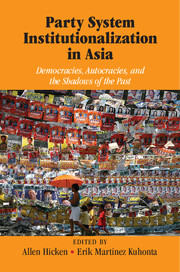Book contents
- Frontmatter
- Dedication
- Contents
- List of Figures
- List of Tables
- List of Contributors
- Acknowledgments
- 1 Introduction: Rethinking Party System Institutionalization in Asia
- 2 The Antidemocratic Potential of Party System Institutionalization: Malaysia as Morality Tale?
- 3 Institutionalized Succession and Hegemonic Party Cohesion in Singapore
- 4 Party System Institutionalization in Japan
- 5 Long in the Making: Taiwan’s Institutionalized Party System
- 6 The Making and Unmaking of the Communist Party and Single-Party System of Vietnam
- 7 The Institutionalization of the Communist Party and the Party System in China
- 8 Party System Institutionalization in India
- 9 Party and Party System Institutionalization in Cambodia
- 10 Explaining Party System Institutionalization in Indonesia
- 11 South Korea’s Weakly Institutionalized Party System
- 12 Thailand’s Feckless Parties and Party System: A Path-Dependent Analysis
- 13 Party and Party System Institutionalization in the Philippines
- 14 Party System Institutionalization: Reflections Based on the Asian Cases
- Index
- References
6 - The Making and Unmaking of the Communist Party and Single-Party System of Vietnam
Published online by Cambridge University Press: 18 December 2014
- Frontmatter
- Dedication
- Contents
- List of Figures
- List of Tables
- List of Contributors
- Acknowledgments
- 1 Introduction: Rethinking Party System Institutionalization in Asia
- 2 The Antidemocratic Potential of Party System Institutionalization: Malaysia as Morality Tale?
- 3 Institutionalized Succession and Hegemonic Party Cohesion in Singapore
- 4 Party System Institutionalization in Japan
- 5 Long in the Making: Taiwan’s Institutionalized Party System
- 6 The Making and Unmaking of the Communist Party and Single-Party System of Vietnam
- 7 The Institutionalization of the Communist Party and the Party System in China
- 8 Party System Institutionalization in India
- 9 Party and Party System Institutionalization in Cambodia
- 10 Explaining Party System Institutionalization in Indonesia
- 11 South Korea’s Weakly Institutionalized Party System
- 12 Thailand’s Feckless Parties and Party System: A Path-Dependent Analysis
- 13 Party and Party System Institutionalization in the Philippines
- 14 Party System Institutionalization: Reflections Based on the Asian Cases
- Index
- References
Summary
Introduction
Theorists of parties and party systems disagree about how to conceptualize communist parties and communist single-party systems. Some do not accept communist parties’ claims to be “parties.” Most treat communist single-party systems as a special category separate from other party systems. Not only do communist regimes allow no competitive elections, but critical differences also exist between totalitarian communist systems on the one hand and single-party authoritarian regimes on the other. In this chapter, I argue that there is merit in calling communist systems either single-party systems or single-party dictatorships. Neither concept is perfect; the appropriate use depends on context. It is also useful to separate the communist party from the state dominated by such a party, despite the high degree of overlap between the two in communist countries.
The conceptual discussion clears the ground for an analysis of the Vietnamese case, which has never been accorded in-depth treatment in the literature. Vietnam has one of the longest standing and most stable political regimes in Asia. It also has one of the few remaining communist systems in the world. I use concepts developed by Samuel Huntington to examine separately the historical evolution of the Vietnamese Communist Party (VCP) and the party systems in which it has operated. Essentially the VCP as a party has undergone four phases: expansion (1945–1948), institutionalization (1948–1960), deinstitutionalization (1963–1986), and limited reinstitutionalization (1986–present). By contrast, Vietnam’s party system has experienced three periods: factionalism (1945–1946), institutionalization of the single-party system (1948–1956), and deinstitutionalization (1975–present). During the war from 1959 to 1975, the single-party system experienced certain problems but remained well institutionalized.
Information
- Type
- Chapter
- Information
- Party System Institutionalization in AsiaDemocracies, Autocracies, and the Shadows of the Past, pp. 136 - 161Publisher: Cambridge University PressPrint publication year: 2014
